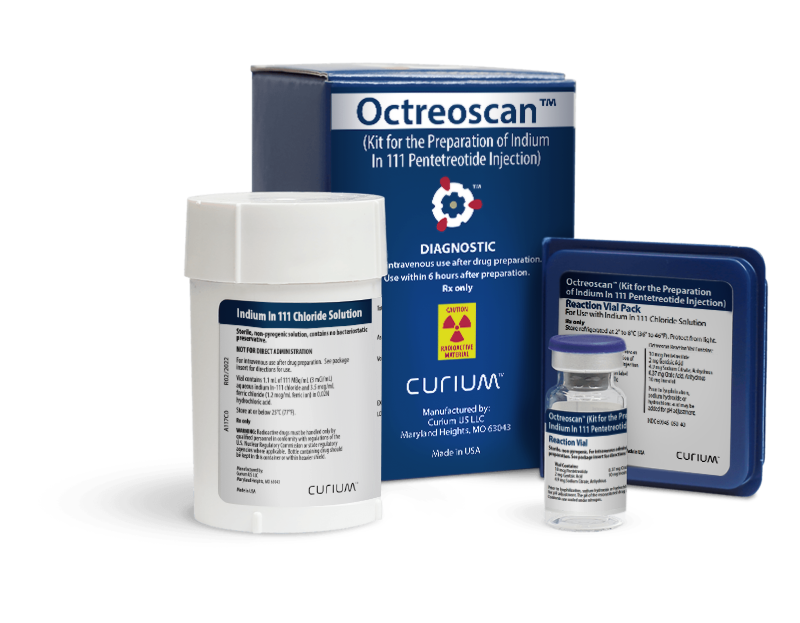

U.S. Spect products | Oncology
Octreoscan™
(kit for the preparation of indium In 111 pentetreotide injection)
This information is intended for U.S. healthcare professionals only.
Product information
To treat the NET, first see the NET.
Octreoscan brings enhanced value to your imaging efforts through:
- Localization of both primary and metastatic neuroendocrine tumors (NETs) bearing somatostatin receptors.1
- Aiding with identification of additional tumor sites not apparent with conventional imaging such as CT and MR.2,3
- Increased diagnostic confidence when used with SPECT/CT imaging techniques.4
- Clarity that can positively impact patient management.3,5
- Helping to identify patients who may benefit from somatostatin-targeted peptide receptor radionuclide therapies (PRRT)4, like lutetium Lu 177 dotatate.
Indication & Usage
Octreoscan, after radiolabeling, is an agent for the scintigraphic localization of primary and metastatic neuroendocrine tumors bearing somatostatin receptors.
Important risk information
Warnings and precautions
- DO NOT ADMINISTER IN TOTAL PARENTERAL NUTRITION (TPN) ADMIXTURES OR INJECT INTO TPN INTRAVENOUS ADMINISTRATION LINES; IN THESE SOLUTIONS, A COMPLEX GLYCOSYL OCTREOTIDE CONJUGATE MAY FORM.
- The sensitivity of scintigraphy with indium In 111 pentetreotide may be reduced in patients concurrently receiving therapeutic doses of octreotide acetate. Consideration should be given to temporarily suspending octreotide acetate therapy before the administration of Indium In 111 Pentetreotide Injection and to monitoring the patient for any signs of withdrawal.
- Hypersensitivity reactions following administration of somatostatin receptor imaging agents predominantly consisted of cutaneous reactions such as rash and pruritus. Reactions reversed either spontaneously or with routine symptomatic management. Less frequently hypersensitivity reactions included angioedema or cases with features of anaphylaxis.
- Therapy with octreotide acetate can produce severe hypoglycemia in patients with insulinomas. Precautions should be taken to prevent hypoglycemia in these patients.
- The contents of the two vials supplied with the kit are intended only for use in the preparation of Indium In 111 Pentetreotide Injection and are NOT to be administered separately to the patient.
- As with any other radioactive material, appropriate shielding should be used to avoid unnecessary radiation exposure to the patient, occupational workers, and other persons.
- Radiopharmaceuticals should be used only by physicians who are qualified by specific training in the safe use and handling of radionuclides.
- To help reduce the radiation dose to the thyroid, kidneys, bladder, and other target organs, patients should be well hydrated before the administration of Indium In 111 Pentetreotide Injection. It is also recommended that patients be given a mild laxative before and after administration of Indium In 111 Pentetreotide Injection.
- Indium In 111 Pentetreotide Injection should be tested for radiolabeling yield of radioactivity prior to administration. The product must be used within 6 hours of preparation.
- To maintain sterility, it is essential that directions are followed carefully. Aseptic technique must be used during the preparation and administration of Indium In 111 Pentetreotide Injection.
- Octreotide acetate and the natural somatostatin hormone may be associated with cholelithiasis, presumably by altering fat absorption and possibly by decreasing motility of the gallbladder. A single dose of Indium In 111 Pentetreotide Injection is not expected to cause cholelithiasis.
Adverse reactions
- Serious adverse reactions may include bradycardia and decreased hematocrit and hemoglobin (one reported case of each in clinical trials involving 538 patients).
- Adverse effects observed at a rate less than 1% of 538 patients include dizziness, fever, flush, headache, hypotension, changes in liver enzymes, joint pain, nausea, sweating, and weakness. These adverse effects were transient.
- False Positive/False Negative Results: From the clinical trials, overall, including all tumor types with or without the presence of somatostatin receptors, there were 3/508 false positives and 104/508 false negatives.
- Pentetreotide is derived from octreotide which is used as a therapeutic agent to control symptoms from certain tumors. The usual dose for Indium In 111 Pentetreotide Injection is approximately 5 to 20 times less than for octreotide and is subtherapeutic.
- Common adverse reactions of octreotide include nausea, injection site pain, diarrhea, abdominal pain/discomfort, loose stools, and vomiting.
- Hypertension and hyper- and hypoglycemia have also been reported with the use of octreotide.
Use in specific populations
- Nursing mothers: It is not known if this drug is excreted in human milk; caution should be exercised when Indium In 111 Pentetreotide Injection is administered to a nursing woman.
- Pediatrics: Safety and effectiveness have not been established in pediatric patients.
- Since indium In 111 pentetreotide is eliminated primarily by renal excretion, use in patients with impaired renal function should be carefully considered.
- Animal reproduction studies have not been conducted with indium In 111 pentetreotide. It is not known whether indium In 111 pentetreotide can cause fetal harm when administered to a pregnant woman or can affect reproduction capacity. Therefore, Indium In 111 Pentetreotide Injection should not be administered to a pregnant woman unless the potential benefit justifies the potential risk to the fetus.
Frequently asked questions
Store the reaction vial containing the Indium In 111 Pentetreotide Injection at controlled room temperature 20° to 25°C (68° to 77°F) until use. It must be used within 6 hours of preparation.
Octreoscan can be ordered through your local Sales Representative, or our Customer Service Department at 888.744.1414, option 1 then option 2. Orders are accepted Monday – Friday, 7:00 am to 5:00 pm. CST.
Call Curium Pharmacovigilance / Product Monitoring Department at 866.789.2211
How is this product supplied
Order information
| Description | Qty | Unit | Size | Order # | NDC |
|---|---|---|---|---|---|
| Octreoscan kit, 1 vial | 1 | Each | – | N050D0 | 69945-050-40 |
References
1 Octreoscan [package insert]. Maryland Heights, MO: Curium US LLC; 2022. 2 Krenning E, Kwekkeboom D, Pauwels S, Kvols L, Reubi J. Somatostatin receptor scintigraphy. In: Freeman L, ed. Nuclear Medicine Annual 1995. New York: Raven Press; 1995:1-50. 3 Lebtahi R, Cadiot G, Sarda L, et al. Clinical impact of somatostatin receptor scintigraphy in the management of patients with neuroendocrine gastroenteropancreatic tumors. J Nucl Med. 1997;38(6):853-858. 4 Lu SJ, Gnanasegaran G, Buscombe J, Navalkissoor S. Single photon emission computed tomography/computed tomography in the evaluation of neuroendocrine tumours: a review of the literature. Nucl Med Commun. 2013;34(2):98-107. doi:10.1097/ MNM.0b013e32835bd59d. 5 Rufini V, Calcagni ML, Baum RP. Imaging of neuroendocrine tumors. Semin Nucl Med. 2006;36(3):228-247.